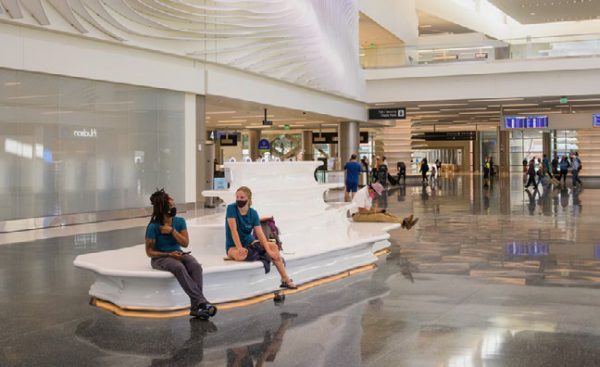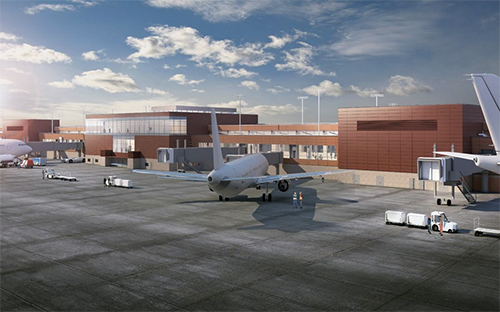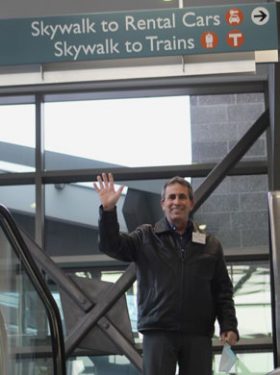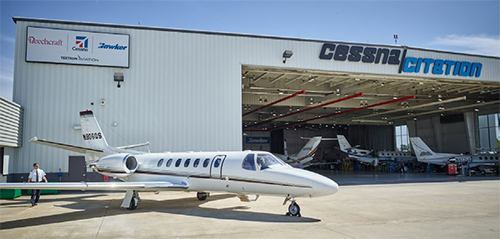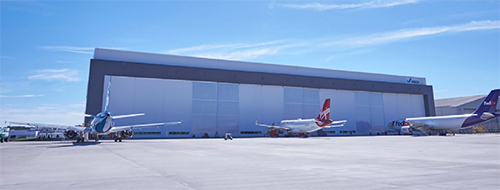
Airports Signaling There’s a Recovery on the Horizon
08 Apr, 2021
Airport flight and passenger activity hit the pause button in early 2020 due to the pandemic. Many are still in a holding pattern in terms of development.
But that hasn’t stopped all airport development. In fact, it has helped accelerate some projects.
Many projects that were planned for 2020 were either cancelled or delayed because of the pandemic, according to a survey of members by the Airport Consultants Council, an airline industry trade group. Over 90 percent of airport construction companies have experienced delays or cancellations of projects, with 21 percent of companies experiencing major delays.
But some projects were able to continue. For example, on October 27, 2020, Salt Lake City International Airport (SLC) completed phase 1 of a $4.1 billion redevelopment project that features operational and other upgrades throughout the airport, including a new 908,754-square-foot terminal.
Demolition to prepare for phase 2 at the SLC airport began this February, with completion expected by late 2024. The second phase may actually get accelerated due to lower passenger traffic through the airport, according to reports from airport officials.
The project hit a number of delays over the course of the major development that had been planned since the late 1990s, with a few snags along the way, including 9-11 and the 2008 recession when some airlines using the airport declared bankruptcy.
Construction began with a ground-breaking in 2014. The first phase included building a new parking structure, one central terminal, and the west end of Concourse A. In May, 2016, the west end of Concourse B was built.
Initially the plan was to use some of the older facilities—those older concourse gates—after building a bridge that connected the main terminal to those old concourses.
“When the pandemic hit and our numbers dropped, we recognized that we wouldn’t need those gates,” Nancy Volmer, director of communications and marketing for SLC, says. “So a decision was made to shut down all of the old facilities once we opened Concourse B in late October, and demolish all of the old facilities rather than do it in a phased approach. That is what is helping us to speed up the construction timeline for phase 2. It is expected to save us up to $300 million.”
In mid-February last year, during the ski season, they were seeing 30,000 passengers a day come through the airport, Volmer says. At the lowest point in the pandemic, around September, they were down to just 1,500 passengers coming through.
She says that it was really to their benefit to open the airport with fewer passengers in 2020. “You get more of a chance to see passengers interact with the new facility and then make changes, or add more signage for example, and see what we needed to tweak to make the passenger experience more pleasant,” she says.
SLC will have their non-stop flights to Paris and Amsterdam coming back on the schedule for this spring, Volmer says. Another example of a silver lining in the pandemic cloud is San Francisco International Airport (SFO), which is continuing to accelerate its runway improvement projects.
The airport closed one main runway for four months beginning in January to complete upgrades originally scheduled to be worked on in 2022. All work is now scheduled to be completed by Labor Day 2021.
SFO officials chose to move up this construction project because of the reduced flight activity due to the pandemic, coordinating the construction planning with the scheduling of flights by some of the airlines serviced at SFO.
Still in wait-and-see mode
But that sort of good news was more the exception than the rule last year. Look at what has happened globally: Before the pandemic, there were 128,000 worldwide flights every day on 1,478 commercial airlines carrying 12.5 million passengers and $18 billion of goods, according to the International Air Transport Association (IATA). The commercial airline industry supported 8.8 million jobs in North America alone.
But in 2020, there was a 61 percent drop in worldwide aviation revenue (which includes a 46 percent drop in North America alone), and a 66 percent drop in passengers, according to the IATA. “Airports need to do more to increase the operating capacity of existing infrastructure and governments need to encourage and facilitate timely and cost-effective expansion of congested airports and airspace,” the IATA concluded.
The pandemic has caused a hit-and-miss attempt regarding future planning. “On a case-by-case basis, some airlines and/or airports have continued with ongoing projects, while others have been scaled back or suspended,” Perry Flint, head of USA corporate communications for the IATA, wrote in an email response to an inquiry by BXJ. “But aviation is in its gravest crisis. At the industry level, the focus is on survival, not adding capacity and infrastructure.”
Help is on the radar
In a letter to congressional leaders on July 9, 2020, Todd Hauptli, president and CEO of American Association of Airport Executives (AAAE), and Kevin Burke, president and CEO of Airports Council International-North America (ACI-NA), pleaded for help. “Passenger levels declined by as much as 95 percent system-wide for an extended time and are still at only 20 to 25 percent of previous levels,” Hauptli and Burke wrote to Congress. “Billions of dollars in revenue that airports expected to be generated by travelers have evaporated. Billions more in anticipated passenger facility charge collections have also disappeared, depriving airports of a key source of revenue to support bond payments. Airports hold nearly $100 billion in collective debt, with some $7 billion in airport bond principal and interest payments due in 2020.”
Funding from the March, 2020, $2.2 trillion Coronavirus Aid, Relief, and Economic Security Act (CARES), they wrote, has provided a critical lifeline to airports in the near-term that will protect jobs, enhance cleaning and sanitization efforts, ensure that debt payments can be made and help keep construction projects moving forward. “Unfortunately, the relief provided by CARES Act funding is only temporary given the depths of the crisis.”
Safety and the internet of things
As the pandemic continues, going forward it’s all about passenger—and worker—safety in airports.
One example of how to make airports cleaner and safer comes from the Hartsfield-Jackson Atlanta International Airport.
Dr. Kofi Smith, president and CEO of the Atlanta Airlines Terminal Company (AATC) has responsibility for the central passenger terminal complex of the airport. Smith has integrated big data, cloud technology, mobile technology, artificial intelligence and collaborative smart machines at the airport. The airport has a real-time dashboard showing the cleaning schedules and inspections for all of the airport spaces, assets, and washrooms, according to the white paper explaining how the system works.
Each area and their related inspections are scored and published so an employee or traveling passenger is aware of what has been done to ensure their safety. The busiest areas and restrooms at the airport have sensors with smart toilet paper holders, paper towels, trash and visual lighting sensors—with a wireless link from Georgia Pacific and other partners—to share information via cloud-based processing and data storage with facility managers and their staff.
Other internet-of-things ideas to be added include artificial intelligence with a facial recognition feature to help understand what a passenger in the terminal either likes or doesn’t like—by analyzing their smiles or frowns—so the airport knows which services to upgrade or enhance.
Leading edge still sharp
Even as the airport industry deals with the pandemic, new ideas in passenger air travel are being explored.
One example comes from Ferrovial, a global infrastructure operator, working in partnership with Lilium, an aviation company to develop an all-electric, vertical take-off and landing (eVTOL) jet aircraft and service that is working a niche between large scale commercial airline travel and small private jet travel.
The companies are in the early stages of developing a network of at least ten vertiports connecting various locations in Florida.
Vertiports will provide infrastructure for landing, recharging, and taking off with passengers. Ferrovial and Lilium will collaborate in designing and constructing the vertiport facilities as well as the operation and maintenance of the vertiports for passenger service.
The first location in south Florida is expected to be announced soon. Once all the vertiports are built in the state, nearly 20 million Florida residents will live within 30 minutes of at least one of them, according to company officials.
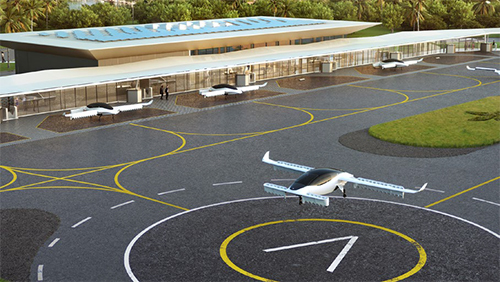
Artist conception of an all-electric vertical take off and landing jet developed by Lilium, landing at a veriport in Florida developed by Ferrovial, an infrastructure developer.
Evolving to a smart airport
Airport development is becoming more focused on transitioning to a smart airport, in part because of the pandemic and the need for fewer touchpoints passengers. But the transition is occurring because of other issues as well: passenger wait times, security check-ins, less real-time information, flight delays, less space in airport, lack of proper customer service, improper baggage handling, lost baggage complaints and more.
According to Market Study Report, a Delaware-based market studies company, to help overcome all these problems, airports across the globe are working towards smart airport development to provide a better and seamless personalized experience for the passenger. The North American smart airport market size is expected to reach $7.74 billion by 2026.
Smart airport security system technology is driving the market as various airports are implementing new innovative smart components such as flight booking management, automatic check-in, and more.
Modernization of old airports, introduction of new airports, development in commercial aviation, and increasing focus on green initiatives are the key growth drivers expected to boost the market for smart airports in North America, according to the report.
Side Bar
City of Warwick, RI, is home to T.F. GREEN AIRPORT
Located in the heart of southern New England, the City of Warwick, RI, is home to T.F. Green Airport and the InterLink intermodal commuter rail station, making their community very well positioned to offer unique development opportunities for businesses looking to capitalize on our proximity to air, rail, and Interstates 95 and 295.
Ease of travel is important for employees and business clients alike, and T.F. Green offers that and more. The InterLink is connected to the terminal via a skywalk, providing expedient and efficient access to rental car companies, the MBTA commuter rail, and public bus transportation. In fact, T.F. Green’s reputation for convenience, short lines, and affordable parking has recently earned it honors in “best of” rankings in Travel + Leisure, Condé Nast Traveler and USA Today readers’ choice awards. There’s also legislation pending before the state General Assembly that would change the name to “Rhode Island T.F. Green International Airport,” which would raise the airport’s brand awareness further.
The City is capitalizing on its role as host to the airport and the convergence of air, rail, and interstate with the creation of City Center Warwick, comprised of more than 100 acres surrounding the airport and InterLink. Our award-winning City Centre Master Plan, which envisions a “live/work/play” environment, offers development opportunities supported by accommodating zoning and streamlined permitting for the area, with Tax Stabilization Agreements (TSAs) for qualified projects – all of which make City Centre an attractive and feasible location for development. A market analysis has found that the area would support a number of industries, including, but not limited to, foreign trade, education, financial companies, distribution and high-end manufacturing.
They’re now seeing this transformative vision become a reality with projects that include construction of the Hyatt Place Hotel, renovation of both Fairfield Inn & Suites by Marriott and the Radisson Hotel, and construction of the Seasons Corner Market. The Hilton Garden Inn, a brownfields redevelopment, was sold for $25 million to a Wall Streetbased investment company, and the adjacent IronWorks Tavern has been purchased by a Rhode Island-based hospitality group. That’s all in addition to a $3-million investment in safety and aesthetic improvements along one of City Centre’s major corridors and a $2.8 million federal grant that’s funding a feasibility study of Amtrak rail service at the InterLink. Smaller businesses are also investing in exterior and landscaping improvements, niche industries such as Proclamation Ale are finding terrific homes in the district, and a 75-unit condominium and apartment development has recently received master plan and zoning approvals.
The momentum is only continuing, with many mixed-use projects being actively considered by multiple investors. They invite you to contact them to learn how you can be a part of transforming this area’s former manufacturing base into a 21st Century, transit-oriented development and hub of commerce within the regional, national, and global marketplaces.
Side Bar
Piedmont Triad International Airport an Aerospace Employment Center
The Piedmont Triad International Airport in central North Carolina is a hub of aerospace employment thanks to companies such as Honda Aircraft Company, Textron/Cessna, FedEx Express and HAECO Americas – all of which have major operations at the airport.
Employment on the airport campus totals more than 8,600, which makes the airport one of the top five employers in the Piedmont Triad Region, according to the Triad Business Journal, a local business publication. But that’s only part of the story.
A recent economic impact study conducted by researchers at North Carolina State University determined that the airport is responsible for employment of more than 30,000 people in the region and has an annual economic impact of roughly $9 billion – all of this in a traditionally blue-collar region best known until 20 years ago for tobacco, textiles and furniture.
“The Authority believes that the airport has a crucial role to play in local economic development,” says Kevin Baker, the airport’s executive director. “We are a passenger airport, certainly, and we take that responsibility very seriously.
“But our airport is also uniquely positioned to attract and keep large employers. We have an ideal location at the center of the East Coast, we have direct Interstate highway access, we have runway capacity, we have large tracts of land available for development and we have a track record of successfully completing large, complex projects.”
The seeds of PTI’s growth into an economic development powerhouse were first sown about 30 years ago when two major employers moved onto the airport. First, Cessna (now owned by Textron) opened a maintenance base for its Citation line of jets. That service center has now grown to be one of the largest in Textron’s system.
About the same time, TIMCO was founded on the airport as a third-party Maintenance Repair and Overhaul (MRO) operation. TIMCO grew significantly over the years and was later acquired by HAECO. HAECO is one of the largest third-party MRO’s in the world.
The pivotal moment in the region’s aerospace development came 10 years later, when the airport attracted the attention of delivery giant FedEx. The company was looking for a place to locate a 1 million-square-foot Mid-Atlantic Hub, which could sort 24,000 packages an hour overnight and send them back out in the early morning hours.
When the hub opened at the airport in 2009, it had brought with it a new 9,000-foot runway, parallel to the existing 10,000-foot runway, a new highway interchange providing immediate access to nearby Interstate highways and overnight delivery capability that was attractive to companies that were beginning to depend on overnight delivery as a business necessity.
“When FedEx located at the airport, it was a game changer for the Piedmont Triad,” says Stan Kelly, president of the Piedmont Triad Partnership, the region’s economic development organization. “The hub established the region as a viable 21st Century distribution center. Today, in addition to the FedEx air hub, we have a major FedEx Ground hub and an Amazon fulfillment center located nearby.”
Next to arrive at the airport was the Honda Aircraft Company, manufacturer of the HondaJet, which is a top seller in the light jet category. Michimasa Fujino, who developed the innovative design for Honda, completed research and development of the jet at PTI and tested the first prototype there.
When Honda made the commitment The Piedmont Triad International Airport in central North Carolina is a hub of aerospace employment thanks to companies such as Honda Aircraft Company, Textron/Cessna, FedEx Express and HAECO Americas – all of which have major operations at the airport.
Employment on the airport campus totals more than 8,600, which makes the airport one of the top five employers in the Piedmont Triad Region, according to the Triad Business Journal, a local business publication. But that’s only part of the story.
A recent economic impact study conducted by researchers at North Carolina State University determined that the airport is responsible for employment of more than 30,000 people in the region and has an annual economic impact of roughly $9 billion – all of this in a traditionally blue-collar region best known until 20 years ago for tobacco, textiles and furniture.
“The Authority believes that the airport has a crucial role to play in local economic development,” says Kevin Baker, the airport’s executive director. “We are a passenger airport, certainly, and we take that responsibility very seriously.
“But our airport is also uniquely positioned to attract and keep large employers. We have an ideal location at the center of the East Coast, we have direct Interstate highway access, we have runway capacity, we have large tracts of land available for development and we have a track record of successfully completing large, complex projects.”
The seeds of PTI’s growth into an economic development powerhouse were first sown about 30 years ago when two major employers moved onto the airport. First, Cessna (now owned by Textron) opened a maintenance base for its Citation line of jets. That service center has now grown to be one of the largest in Textron’s system.
About the same time, TIMCO was founded on the airport as a third-party Maintenance Repair and Overhaul (MRO) operation. TIMCO grew significantly over the years and was later acquired by HAECO. HAECO is one of the largest third-party MRO’s in the world.
The pivotal moment in the region’s aerospace development came 10 years later, when the airport attracted the attention of delivery giant FedEx. The company was looking for a place to locate a 1 million-square-foot Mid-Atlantic Hub, which could sort 24,000 packages an hour overnight and send them back out in the early morning hours.
When the hub opened at the airport in 2009, it had brought with it a new 9,000-foot runway, parallel to the existing 10,000-foot runway, a new highway interchange providing immediate access to nearby Interstate highways and overnight delivery capability that was attractive to companies that were beginning to depend on overnight delivery as a business necessity.
“When FedEx located at the airport, it was a game changer for the Piedmont Triad,” says Stan Kelly, president of the Piedmont Triad Partnership, the region’s economic development organization.
“The hub established the region as a viable 21st Century distribution center. Today, in addition to the FedEx air hub, we have a major FedEx Ground hub and an Amazon fulfillment center located nearby.”
Next to arrive at the airport was the Honda Aircraft Company, manufacturer of the HondaJet, which is a top seller in the light jet category. Michimasa Fujino, who developed the innovative design for Honda, completed research and development of the jet at PTI and tested the first prototype there.
When Honda made the commitment to manufacture the new type of jet, competition was fierce to have the company locate in larger cities around the country. Airport officials went to work to make the case for Honda to locate at PTI.
“Honda is an aircraft manufacturer,” Baker says, “which means that they would be a large employer providing good jobs. Attracting a company like that is something that every community would like to do.”
Honda’s decision to locate at the airport solidified PTI as ground zero for a growing aerospace industry that has taken root in the Piedmont Triad, a region of moderate temperatures and gently rolling hills in the heart of North Carolina anchored by the three cities of Greensboro, High Point and Winston-Salem. The region is now home to nearly 200 aerospace companies.
In 2014, when international maintenance and repair giant HAECO purchased TIMCO, and made the airport facility its North American headquarters, the airport’s aerospace trifecta was complete. Now the airport was home to key companies from the cargo sector, from the manufacturing sector and from the third-party maintenance and repair sector.
“Two decades ago, our region faced a crisis,” says Kelly, president of the Piedmont Triad Partnership. “Tobacco and textiles were leaving. We needed to diversify. The airport became the lynchpin of a new industry for us – aerospace.”
PTI leadership is still looking forward. The Airport Authority has acquired and cleared more than 1,000 acres of new property, all with direct access to the airfield and served by numerous interstate highways. The airport sites have been graded, received preliminary environmental approval and are ready for development.
“We understand that when aerospace companies decide to develop a new location, they don’t want to wait for a site.” Baker says. “When the next aerospace opportunity presents itself, we will be ready.”
Related Posts
-

Agri-technology adoption begins in earnest amidst the digitization of farming
-
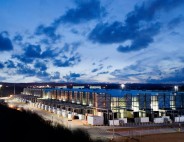
New Sustainability, New Power Handling Ideas are Part of Data Center Evolution
-

A Huge Industry Begins Reworking Itself
-
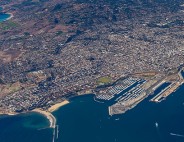
Global and U.S. Seaports Struggling in a State of Economic Flux
-

More Foreign Trade Zones Handling an Ever Growing Bounty of Goods
-

Business Services and Strategic Planning
-

The Industrial Manufacturing Revolution Is Already Under Way
-

Innovations Driving Demand
-

Intermodal Expansion
-
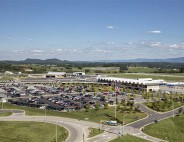
Development with Wings


